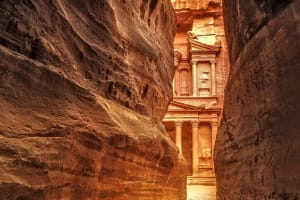Petra Vacations & Travel
Petra Vacations
Petra, located in Jordan, is a historical and archaeological wonder renowned for its captivating rock-cut architecture and fascinating history. Often referred to as the "Rose City" due to the color of the stone it's carved from, Petra was the capital of the Nabataean Kingdom and an essential hub for trade routes during ancient times.
Region: Jordan
Overview
One of the most iconic sites within Petra is the Treasury (Al-Khazneh), a stunning temple carved into the sandstone cliffs, famously featured in the movie "Indiana Jones and the Last Crusade." The Monastery (Ad-Deir) is another remarkable feat of architecture, accessible via a steep climb, offering breathtaking views of the surrounding landscape. The Siq, a narrow and winding gorge, serves as the dramatic entrance to Petra. The Street of Facades is a row of monumental tombs, showcasing unique Nabataean craftsmanship. The Roman Theater is an outstanding rock-carved theater reflecting Petra's diverse history. Lastly, the High Place of Sacrifice provides a vantage point for panoramic views of the entire archaeological site.
What to See
The Siq – This long, narrow, winding gorge lined with soaring cliffs is the main road leading to Petra. Visitors emerge at The Treasury, one of the world’s most famous façades. Although many rush through the Siq anxious to see Petra, this magical corridor is well worth the time.
The Treasury – Also known as Al-Khazneh, it is the most iconic rock-cut façade at Petra, a UNESCO World Heritage Site, and the first site visitors see. The Treasury is ornamented with columns, a frieze and more, and crowned by a funerary urn.
Roman Theater – Hewn from the rock over 2,000 years ago, this impressive theater is located at the foot of the High Place of Sacrifice, which offers awe-inspiring views of Petra. Originally carved by the Nabataeans, the Romans later enlarged the theater to accommodate more than 8,000 people.
The Monastery – Ad Deir, as it’s known in Arabic, is Petra’s second-most visited site after The Treasury, but no less impressive. The Monastery, built in the 3rd century BC as a Nabataean tomb, is located in the high hills and is much larger than The Treasury. Bedouins named it “The Monastery” because of the crosses inscribed on its interior wall, suggesting it was used as a church during Byzantine times.
The Treasury – Also known as Al-Khazneh, it is the most iconic rock-cut façade at Petra, a UNESCO World Heritage Site, and the first site visitors see. The Treasury is ornamented with columns, a frieze and more, and crowned by a funerary urn.
Roman Theater – Hewn from the rock over 2,000 years ago, this impressive theater is located at the foot of the High Place of Sacrifice, which offers awe-inspiring views of Petra. Originally carved by the Nabataeans, the Romans later enlarged the theater to accommodate more than 8,000 people.
The Monastery – Ad Deir, as it’s known in Arabic, is Petra’s second-most visited site after The Treasury, but no less impressive. The Monastery, built in the 3rd century BC as a Nabataean tomb, is located in the high hills and is much larger than The Treasury. Bedouins named it “The Monastery” because of the crosses inscribed on its interior wall, suggesting it was used as a church during Byzantine times.



